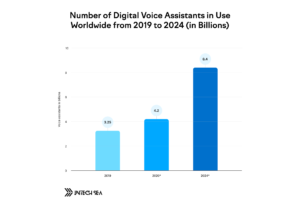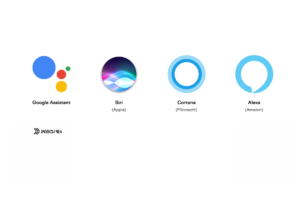What is voice search optimization?
Voice search is transforming the landscape of digital marketing. It’s not just a trend; it’s becoming a big part of how people find information online. Let’s take a closer look at what voice search optimization is all about and how you can make it work for your business.

The Rise of Voice Search
Voice search isn’t new, but it’s growing fast. Here are some eye-opening stats:
- By 2024, there will be about 8.4 billion voice assistants in use worldwide.
- Voice search has been used by 58% of consumers to find local company information.
- 27% of the world’s internet users utilize voice search on their mobile devices.
These numbers show that voice search is here to stay. People are using it for all sorts of things, from checking the weather to finding local businesses.

The Evolution of Voice Search
Voice search has come a long way since its early days. Let us go back in time a little bit:
- Early 2000s: IBM introduces the first speech recognition software, but it’s clunky and not very accurate.
- 2008: Google launches its voice search app for iPhones. It’s a game-changer, but still has limitations.
- 2011: Apple introduces Siri, making voice search more conversational and accessible.
- 2014: Amazon’s Alexa enters the scene, bringing voice search into people’s homes.
- 2016: Google Assistant launches, offering more accurate and context-aware voice search.
- 2019 onwards: Voice search becomes increasingly sophisticated, with better natural language processing and more integration with daily life.
Today, voice search is more accurate, more natural, and more useful than ever before. It’s not just about speaking a search query – it’s about having a conversation with your device.
How Voice Search Works
When someone uses voice search, they’re usually talking to a digital assistant like Siri, Google Assistant, or Alexa. The assistant uses speech recognition to understand the question, then searches the internet for an answer.
Here’s the cool part: these assistants often read the answer out loud. That means only one result gets spoken – usually the featured snippet or the top result. This makes ranking high even more important for voice search than for regular search.
The Difference Between Voice and Text Search
Voice searches are different from typed searches in a few key ways:
- They’re longer: Voice searches are often full sentences or questions.
- They’re more conversational: People speak more naturally than they type.
- They’re often local: Many voice searches are looking for nearby information.
- They’re often action-oriented: People use voice search when they want to do something, like find a restaurant or make a purchase.
Key Strategies for Voice Search Optimization
Ready to optimize for voice search? Here are some methods to help you get started:
Focus on long-tail keywords
Remember, voice searches are usually longer and more specific than typed searches. You can wonder, “What is the greatest pizza establishment near me in New York City?” rather than “best pizza NYC.”
To optimize for these longer queries:
- Use natural language in your content.
- Include question phrases (who, what, where, when, why, how).
- Think about the specific questions your customers might ask.
Create FAQ Pages
FAQ pages are great for voice search. They naturally use the question-and-answer format that many voice searches follow. Plus, they give you a chance to use those long-tail keywords we talked about.
When creating your FAQ page:
- Use questions people actually ask (check your customer service logs).
- Keep answers concise and to the point.
- Structured data can assist search engines in better understanding your content.
Optimize for local searches
Many voice searches are looking for local information. “Where’s the nearest gas station?” or “Is there a pharmacy open now?” are common voice queries.
To optimize for local voice searches:
- Claim and optimize your Google My Business listing.
- Incorporate your city and neighborhood names into your article.
- List your business in local directories.
Improve Your Site Speed
Voice search results often come from fast-loading sites. Google knows that people using voice search want quick answers. A slow site could mean losing out on voice search traffic.
To speed up your site:
- Compress images
- Use browser caching.
- Minimize redirects
Use Schema Markup
Schema markup is code that you put on your website to help search engines understand your content better. It’s especially helpful for voice search because it can provide quick, direct answers to questions.
Some useful schema markups for voice search include:
- Local Business
- FAQ
- How-to
- Event
Aim for featured snippets.
Featured snippets are the boxes that appear toward the top of Google search results. They are frequently the source of voice search results. In fact, 40.7% of all voice search answers come from featured snippets.
To increase your chances of getting a featured snippet:
- Answer questions concisely.
- Use bullet points or numbered lists.
- Include the question in your content.
Mobile optimization is a must.
Most voice searches happen on mobile devices. If your site isn’t mobile-friendly, you’re probably missing out on voice search traffic.
Make sure your site is mobile optimized by:
- Using a responsive design
- Making buttons and links easy to tap
- Avoiding pop-ups that are hard to close on mobile
Use Natural Language
Voice searches are conversational. People talk to their devices like they’re talking to a person. Your content should match this natural language.
Tips for using natural language:
- Write like you speak.
- Use contractions (it’s, you’re, we’re).
- Include question words in your headers.
Focus on User Intent
Understanding why someone is searching is key to voice search optimization. Are they looking to buy something? Find information? Get directions?
To optimize for user intent:
- Create content that answers specific questions.
- Provide clear, actionable information.
- Consider the context of the search (time, location, etc.).
Optimize for “Near Me” searches
“Near me” searches are huge in voice search. People often ask their devices about businesses or services close to them.
To optimize for “near me” searches:
- Include your city and neighborhood in your website’s title tags, headers, and content.
- Make sure your name, address, and phone number are consistent across the web.
- Use location-specific pages if you have multiple locations.
Create Content for Each Stage of the Customer Journey
Voice searches can happen at any stage of the customer journey. Someone might ask for general information, comparisons between products, or specific details about your business.
Create content for:
- Awareness stage: General information about your industry or product category
- Consideration stage: comparisons, reviews, and detailed product information
- Decision stage: pricing, availability, and purchase information
Don’t forget about branded searches.
People often use voice search to find specific information about brands they know. Make sure you’re optimizing for these branded searches.
Include content about:
- Your store hours
- Your locations
- Your products or services
- Your contact information
Use conversational keywords.
Instead of just focusing on traditional keywords, think about the phrases people use when they speak. These conversational keywords can help you match voice queries better.
For example:
- Instead of “weather forecast,” use “what’s the weather like today?”
- Instead of “best restaurants,” use “where can I eat near me?”
Optimize for Different Voice Assistants
Different voice assistants might pull information from different sources. Siri often uses Bing, while Google Assistant uses… well, Google.
To cover your bases:
- Don’t ignore Bing optimization.
- Consider optimizing for Amazon’s Alexa if it’s relevant to your business.
Keep testing and adjusting.
Voice search is still evolving. What works today might not work as well tomorrow. Keep an eye on your analytics and be ready to adjust your strategy as needed.
Some things to track:
- Which queries are bringing voice search traffic to your site?
- How do voice search visitors interact with your site?
- Which pages are performing best for voice search?
Wrapping Up
Voice search optimization is all about making your content more conversational and accessible. It’s about understanding how people talk and what they’re looking for when they use voice search. By following these strategies, you can make your content more voice-search-friendly and potentially reach a whole new audience.
Remember, voice search isn’t replacing traditional search – it’s adding to it. By optimizing for both, you’re covering all your bases and making sure your content is findable, no matter how people are searching.
So, go ahead and start optimizing for voice search. Your future customers might just be asking their devices about you right now!







